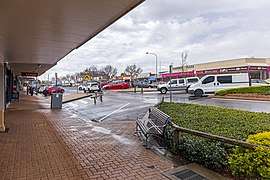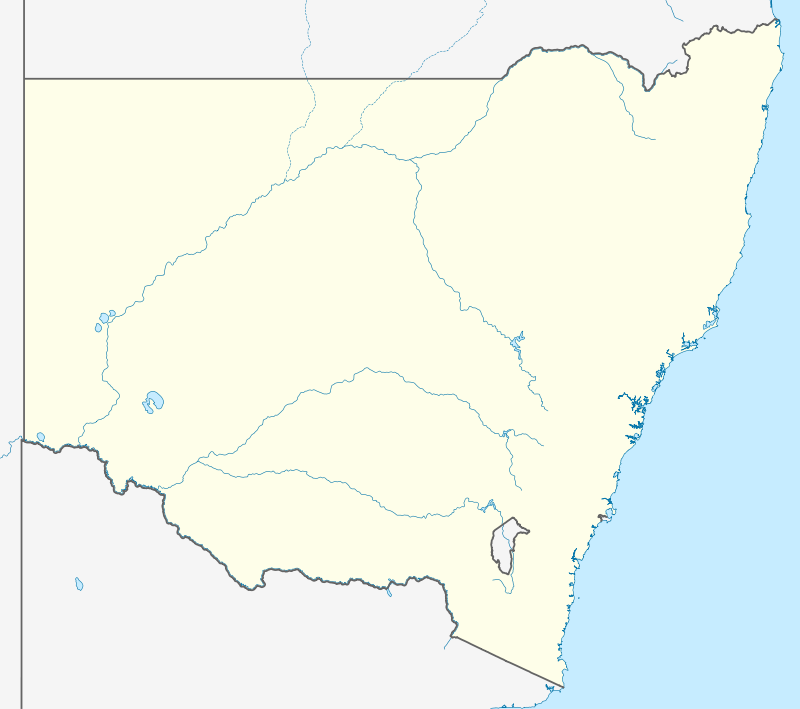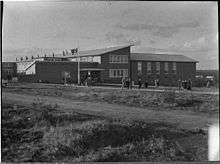Kurri Kurri, New South Wales
Kurri Kurri is a small town in the Hunter Region of New South Wales, Australia, in the Cessnock LGA. At the 2016 census, its population was 6,044.[1] Kurri Kurri is the largest town in a group of towns and hamlets, including Stanford Merthyr, Pelaw Main, Weston, Abermain and Heddon Greta, called Kurri Kurri – Weston by the ABS. Its estimated population was 17,241 at 2016 census.[2]
| Kurri Kurri City of Cessnock, New South Wales | |||||||||||||||
|---|---|---|---|---|---|---|---|---|---|---|---|---|---|---|---|
 Lang Street in Kurri Kurri | |||||||||||||||
 Kurri Kurri | |||||||||||||||
| Coordinates | 32°49′0″S 151°29′0″E | ||||||||||||||
| Population | 6,044 (2016 census)[1] | ||||||||||||||
| • Density | 1,106.7/km2 (2,866/sq mi) | ||||||||||||||
| Established | 1902 | ||||||||||||||
| Postcode(s) | 2327 | ||||||||||||||
| Elevation | 40 m (131 ft)Note1 | ||||||||||||||
| Area | 5.1 km2 (2.0 sq mi)Note2 | ||||||||||||||
| Time zone | AEST (UTC+10) | ||||||||||||||
| • Summer (DST) | AEDT (UTC+11) | ||||||||||||||
| Location | |||||||||||||||
| LGA(s) | City of Cessnock | ||||||||||||||
| Region | Hunter | ||||||||||||||
| County | Northumberland | ||||||||||||||
| Parish | Heddon | ||||||||||||||
| State electorate(s) | Cessnock | ||||||||||||||
| Federal Division(s) | Paterson | ||||||||||||||
| |||||||||||||||
Kurri Kurri's name comes from the local Awabakal language where it has a meaning similar to "the beginning" or "the first".[3]
The town's economy today consists mostly of trades and industry. [4]
Foundation
Kurri Kurri was founded in 1902 to service the local Stanford Merthyr and Pelaw Main collieries and mining communities. The town was named by District Surveyor T. Smith who chose the name because he believed it meant 'hurry along' in a local dialect.
The Kurri Kurri Hotel (1904) is one of several built during the era of mining prosperity in the early 20th century. It is an impressive three-story building featuring prominent verandas with cast-iron lacework. The Empire Tavern was also built during this period. Kurri Kurri has numerous small miners' cottages from the same period.
Population
According to the 2016 census of Population, there were 6,044 people in Kurri Kurri.
- Aboriginal and Torres Strait Islander people made up 7.6% of the population.
- 86.4% of people were born in Australia. The next most common country of birth was England at 1.7%.
- 91.1% of people spoke only English at home.
- The most common responses for religion were No Religion 27.4%, Anglican 24.6% and Catholic 20.4%.[1]
Industry
Coal-mining
Mining at the South Maitland Coalfields began at East Greta in 1891, after an 1886 exploration by Sir Edgeworth David, a government geological surveyor, uncovered the potential of the Greta coal seam. More mines were opened in the early 1900s, supplanting those older pits at Newcastle where the Australian Agricultural Company enjoyed almost a monopoly. During this period there were a number of accidents including the death of six miners at the Stanford Merthyr Colliery in 1905, which is commemorated by a monument in the Kurri Kurri cemetery.
Richmond Main Colliery, also in the Kurri Kurri vicinity, was once the State's largest producer, at 3,400 tons per day, and which reputedly had the deepest shaft permitting access to two separate coal seams, the Scholey shaft, named after its founder, John Scholey. Following the serious slump in the coal industry Stanford Merthyr Colliery closed in 1957, Pelaw Main in 1962, and Richmond Main in 1967.[5]
The power station at Richmond Main Colliery, which provided the electricity for Kurri Kurri and surrounding districts, remained in operation for some years after the mine's closure, until the entire district was attached to the National Grid.
Aluminium smelting
The Kurri Kurri aluminium smelter operated from 1969 to 2012, producing up to 180 kt (180,000 long tons; 200,000 short tons) of aluminium per year.
Crime
Assault
Kurri Kurri had an assault incident rate of 1456.3 per 100,000 population over the period of January 2018 until December 2018, which was significantly higher than the NSW state average of 823.4 per 100,000 population during the same time period.[6]
Theft
Kurri Kurri had a theft incident rate of 4724.9 per 100,000 population over the period of January 2018 until December 2018, which was significantly higher than the NSW state average of 2873.4 per 100,000 population during the same time period.[7]
Railways
Kurri Kurri was served by the South Maitland Railway and originally had two passenger stations – one at Stanford Merthyr, and one on the main SMR line at North Kurri Kurri (opened in June 1904). A new red-brick station building and platform was built at Stanford Merthyr and opened in January 1909. It was renamed Kurri Kurri Station on 3 June 1922. However, with the closure of the SMR's branch line from Aberdare Junction to Stanford Merthyr, due to subsidence, North Kurri Kurri station was renamed Kurri Kurri in the mid-1930s. The station at Stanford Merthyr fell into disuse although the line from the colliery which passed through it was still in operation via the Richmond Vale Railway to Hexham. While passenger services on the South Maitland Railway have ceased, the line is still in use for coal haulage. A new bridge is to be constructed to relocate the railway line to allow construction of the Hunter Expressway.[8]
Local government
Until the creation of the local government area known as the City of Cessnock, Kurri Kurri was the centre of the Shire of Kearsley, which included most of the rural areas and villages around the township of Cessnock and part of the western suburbs of Maitland.
Civic Participation Events
Tidy Towns
In 1988 the town established a Tidy Town Committee under the stewardship of the Keep Australia Beautiful competition. The town achieved immediate success and in the space of 6 years took the best town in NSW in 1993 and was a finalist in the best town in Australia.
This was followed by the establishment of the Small Towns committee known as Towns with Heart.
Mulletfest
A pub-driven event called Mulletfest[9] has been growing in Kurri Kurri for the past two years. The event celebrates the mullet haircut and other aspects of self-identified bogan culture (such as pub rock music). The event has been well received by locals and attracts attendees from around the country.
Nostalgia Festival
Each year Kurri Kurri hosts a 1950s/1960s inspired Nostalgia Festival featuring rock 'n' roll dancing, hot rod and bike shows.[10]
Education

Primary schools
- Kurri Kurri Public School
- Kurri Kurri Infants School
- The Holy Spirit Primary School
- Stanford Merthyr Infants School
- Pelaw Main Public School
- Weston Public School
- Abermain Public School
Secondary schools
- Kurri Kurri High School
Tertiary campuses
- Hunter Institute of TAFE Kurri Kurri Campus
Local art
It is now becoming internationally renowned for its murals with more than 55 murals painted around the town and its environs depicting the history of the region and also recent events.[11]
Sport
Retired Newcastle Knights Rugby league player Andrew Johns spent his childhood in Kurri Kurri, before moving to Cessnock. He would later play in the Kurri Kurri Under-16's side, as Cessnock was unable to field a team. Kurri Kurri is also noted as having produced more Rugby League internationals than any other bush town in Australia.[12]
Kurri Kurri is also home to the 320 m (350 yd) long Loxford Park Speedway, a motorcycle speedway. The speedway has hosted a round of the Australian Solo Speedway Championship every year since 2011 as well as hosting the Australian Sidecar Speedway Championship twice (2012, 2014), the Australian Under-21 Solo Championship on three occasions (2012, 2013, 2015), the Australian Under-16 Solo Championship in 2012, and the NSW Solo Championship each year since 2011. The speedway has also hosted rounds of the Sidecar Grand Slam series and also holds the Jason Crump invitational for solos annually on Boxing Day in honour of Australia's only triple Speedway World Champion. Loxford Park also includes a 135 m (148 yd) junior (under-16) track on its infield.[13]
Heritage listings
Kurri Kurri has a number of heritage-listed sites, including:
- South Maitland Coalfields: Richmond Main Colliery[14]
Notable people
- Luke Ford – writer
- Bill Hamilton – rugby league footballer
- Paul Harragon – rugby league footballer
- Mark Hughes – rugby league footballer
- Bert James – Federal politician
- Richard Johnson – soccer player
- Ernest Llewellyn – violinist, violist
- Eddie Lumsden – rugby league footballer
- Greg McLaren – poet
- George Neilly – NSW State politician
- Sandy Pearson – Australian Army Major General
- Chad Reed – International motocross and supercross racer
- John Sattler – rugby league footballer
- Richard Saunders – sceptic
- Adam Shields – Motorcycle speedway rider
- Jamie Stauffer – Australian Superbike motorcycle racer
- Casey Stoner – Two Time MotoGP World Champion
- Reegan Tanner – rugby league footballer
- Ken Booth – schoolteacher, sportsman and politician
Notes
References
- Australian Bureau of Statistics (27 June 2017). "Kurri Kurri (State Suburb)". 2016 Census QuickStats. Retrieved 21 December 2017.

- Australian Bureau of Statistics (27 June 2017). "Kurri Kurri – Abermain". 2016 Census QuickStats. Retrieved 21 December 2017.

- Threlkeld, Lancelot (1892). An Australian language as spoken by the Awabakal, the people of Awaba, or lake Macquarie (near Newcastle, New South Wales): being an account of their language, traditions, and customs. Charles Potter. p. 221.
- "2016 Census QuickStats: Kurri Kurri". Australian Census Data. Retrieved 12 November 2018.
- "Kurri Kurri". Historical Towns Directory. Australian Heritage Magazine. Retrieved 28 December 2006.
- "NSW Crime Stats". BOCSAR. 29 April 2019.
- "NSW Crime Stats". BOCSAR.
- Tenders NSW Roads and Traffic Authority
- Brown, Jessica (23 February 2019). "Australia's mullet queen has been crowned in Kurri". Newcastle Herald. Retrieved 24 February 2019.
- "Kurri Kurri Nostalgia Festival". Towns With Heart Incorporated. Retrieved 15 January 2008.
- "The Kurri Kurri Mural Project". Kurri Kurri Online. 2005. Archived from the original on 14 December 2007. Retrieved 15 January 2008.
- Walshaw, Nick (23 September 2013). "The Old Legend of Kurri Kurri". The Daily Telegraph. Retrieved 24 September 2013.
- "Kurri Kurri Speedway". kurrikurrispeedway.org.au. Retrieved 27 December 2015.
- "Richmond Main Colliery". New South Wales State Heritage Register. Office of Environment and Heritage. H00016. Retrieved 18 May 2018.
- Eardley, Gifford, H., The Railways of the South Maitland Coalfields, Australian Railway Historical Society, NSW Division, Sydney, 1969: many references therein.